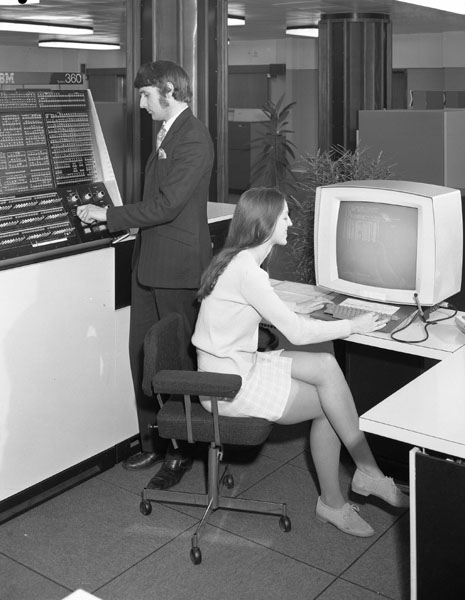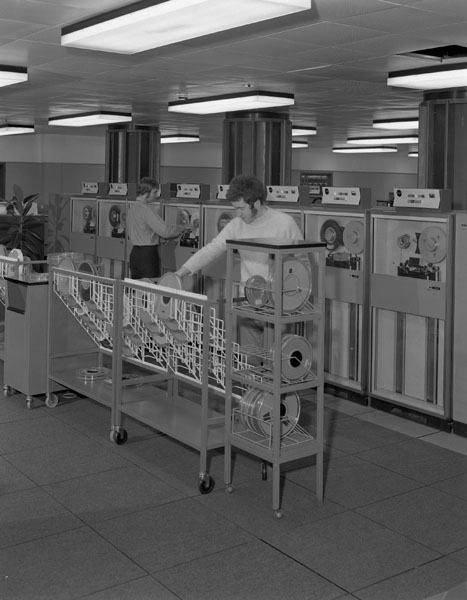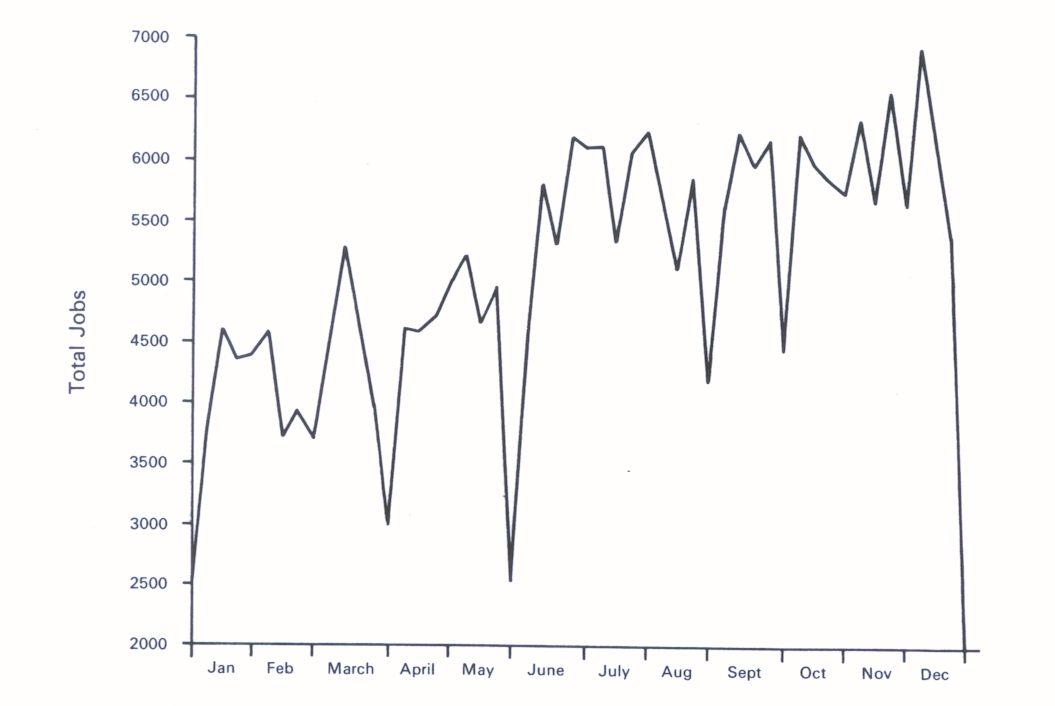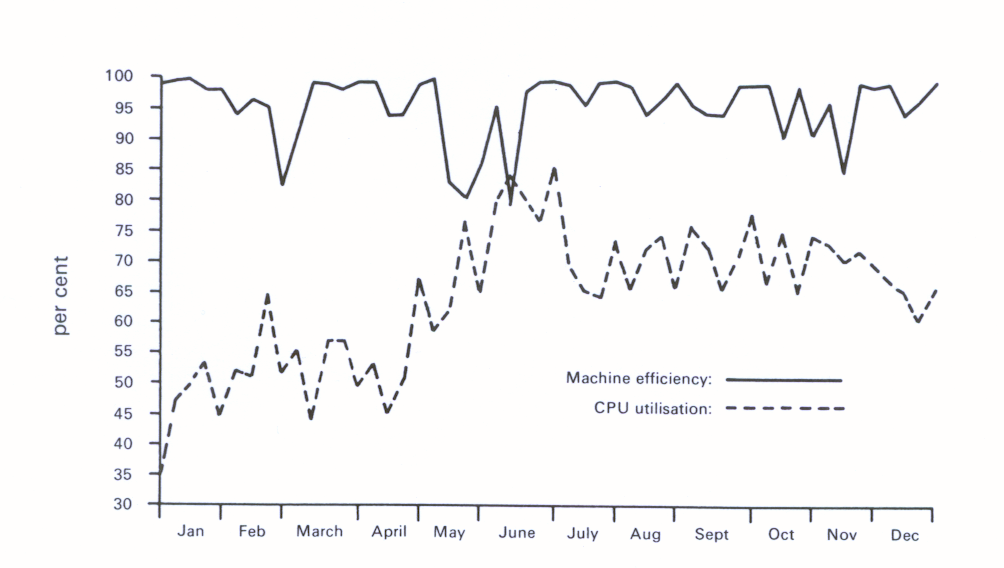

The Computing Centre extended its service to all authorised users of the IBM 370/195 computer on 1st January 1972. During the early part of the year all the original 360/75 peripherals were replaced by 370 type peripherals - the Block Multiplexor, Fixed Head File, 3330 Disk Unit and fast tape drives. The final item, the control console, was added in September.


There has been a marked increase in the number of Remote Job Entry work stations linked to the central computer and operating under HASP-RJE. Many of those now operating with rented equipment will be replaced by purchased GEC 2050 computers during the first quarter of 1973. The location of these stations will be at Imperial College, University College, Bristol, Westfield College, Durham, Queen Mary College, Oxford and CERN. In addition Glasgow and Birmingham have links to existing local IBM computers. Six ports have also been reserved for work stations for ATLAS users, of which one is occupied by the Radio and Space Research Station (RSRS), Slough. Remote work stations have proved remarkably successful and have come into operation with relatively few problems.
Another growth area during the year has been in the use of ELECTRIC - the Rutherford Laboratory data editing, file handling and remote job entry system with output retrieval through a variety of terminals (typewriters, VDU's and graphics displays). The organization of on-line equipment is shown in Figure 98.
The HPD1 and CYCLOPS film measuring machines have been joined by HPD2, which became fully operational on spark chamber film during the year. Film from two experiments (ISR and S104) was measured, and results from the former presented at an international conference in September.
Many users of the Computing Centre are located at universities and one of the most interesting developments during the year has been an extensive programme of installing 'Work Stations' at remote centres. These are linked to the central computer and each comprises at least a card reader and line printer for submitting jobs and receiving output, based on a local computer or other device. At some stations an existing computer originally installed for other purposes has been utilised (e.g. an IBM 360/44 at Birmingham University) and in others a small computer specially purchased will be used. The location and status of all work stations now operating or currently planned are summarised in Table 8.
Information is transmitted to and from the Rutherford Laboratory via the Post Office Datel 2400 service. This offers a leased private telephone link between two points which is available to the renter 24 hours each day. This service is more economical for connect times of more than a few hours per day than the switched public telephone system alternative. Modems to operate at 2400 bits/second are also supplied, and can be attached to the slower switched public network as an insurance against failure of the private lines. This is a valuable diagnostic facility. Twelve Post Office private links have now been installed, and all use Post Office modems except for the link to CERN, Geneva, where it proved necessary to use privately manufactured modems.
| Location | Interim Equipment | Final Equipment | ||
|---|---|---|---|---|
| Type | Status | Type | Status | |
| ICS, London | - | - | PDP 9 | Operational |
| RHEL (Hall 3) | - | - | IBM 1130 | Operational |
| Glasgow | - | - | IBM 360/44 | Operational |
| ICS, London | - | - | IBM 360/44 | Operational |
| Imperial College | IBM 2780 | Operational | GEC 2050 | Not delivered |
| University College | - | - | GEC 2050 | Not delivered |
| Bristol University | - | - | GEC 2050 | Not delivered |
| Westfield College | MOD I | Not tested | GEC 2050 | Not delivered |
| Durham University | IBM 1130 | Operational | GEC 2050 | Not delivered |
| QMC | - | - | GEC 2050 | Not delivered |
| Oxford | IBM 2780 | Operational | GEC 2050 | Not delivered |
| CERN | IBM 2780 | Not tested | GEC 2050 | Not delivered |
| NBRU | - | - | PDP8E | Operational |
| Atlas | - | - | IBM 1130 | Operational |
| RSRS | IBM 2780 | Operational | Undecided | - |
For the central computer end, a Memorex type 1270 communications multiplexor was bought. This makes provision for up to 24 synchronous data links of the Datel 2400 type operating at 2400 bits/second, and asynchronous connections to a further 72 terminals such as typewriters or visual display units, of varying speeds up to 1200 bits/second. All 96 devices can operate simultaneously. This Memorex multiplexor was successfully commissioned during July 1972, replacing the IBM type 2702 and 2703 interfaces.
In general, the remote job entry work station consists of a card reader and line printer connected to a data link (and thence to the central computer) via special purpose hardware or, more frequently, a smaller computer. A data transmission link operating at 2400 bits/ second is capable of supporting a card reader of 200 cards/minute capacity or a line printer at 150 lines/minute in their simplest forms. If the card reader and line printer are attached via a computer (such as the GEC 2050) to the same link, these rates can be raised to 400 cards/minute and 300 lines/minute by interleaving.
After a survey of existing installations the GEC 2050 computer with card reader and line printer was selected as the basis of new work stations at centres without an existing suitable local computer. Eight such stations will be provided by the Rutherford Laboratory.
Remote job entry work stations are supported by the IBM 370/195 HASP-RJE system software. Each station must, however, appear to the system as one of several possible alternative IBM work stations, of which the simplest and slowest is an IBM 2780. So a station based on the GEC 2050 must meet IBM conventions, and this can be achieved by using a program (supplied by GEC) which makes a GEC 2050 simulate an IBM 2780. The GEC 2050 is, however, capable of simulating an IBM 1130, which has twice the performance of an IBM 2780. The simulator program is more complex and does not yet exist, but in collaboration with GEC, the Rutherford Laboratory will provide a suitable simulator program for each work station in the early part of 1973. In due course GEC will take responsibility for maintenance of the IBM 1130 simulator program.
Modifications to HASP and MAST have enabled some work station consoles to be used as ELECTRIC terminals, and further developments will allow auxiliary consoles (such as VDU's and graphics displays) attached to work stations to be similarly used.
Two of the remote job entry work stations are on the Rutherford Laboratory site. The terminal 1130 in Experimental Hall 3 offers card reader, line printer and 7 -track magnetic tape drive facilities, and has had a 60 characters/second VDU added to it during the year. Secondly, the Neutron Beams Research Unit has a PDP8E computer intended primarily for transmitting DEC magnetic tapes to the central computer. A simulator program makes the PDP8E resemble an IBM 2780.
A number of slow speed (10 characters/second) terminals have been linked from various places to the central computer via the switched public telephone network and the asynchronous facilities of the Memorex multiplexor. Six of these dial-up lines are available, and teletypes and graphics terminals have been connected. Although slow they are valuable for remote job submission via ELECTRIC and for small quantities of output (text or graphics) and have functioned successfully.
Within the Laboratory, tests have been made using faster lines and terminals (the 30 characters/second thermal printers and 120 characters/second VDU's). A successful demonstration of remote job submission and output retrieval was given during the 1972 SEAS annual conference in Gotenburg (Sweden), using a teletype in Gotenburg connected to the central computer via the switched public network.
In addition to the six IBM 2741 terminals available at the beginning of the year, two Telterm VDU's and two Texas thermal printers have been made available for public use in the data preparation area during the year.
The new IBM 3270 console equipment including three VDU's was installed on the central computer during the year. These can communicate with ELECTRIC and system management operations for ELECTRIC are now directed from the main console.
Another terminal not publicly available is the T4002 display dedicated to the Bubble Chamber Research Group and used by them for graphics work and output retrieval. It is connected via the slow multiplexor and a 9600 bits/second serial interface to the DDP224 satellite computer.
During the year there has been no basic change in the operating system software for the 370/195. The current system in use is OS/MVT/HASP with some local additions which are described later. On-line activities are supported by Rutherford Laboratory software (MAST/DAEDALUS/ELECTRIC) which has been described in detail in previous reports. At the end of 1971, release 20.1 was introduced to support the IBM 2305 fixed head file and the 3330 large-capacity disk store. About mid-year release 21.0 was introduced to support the 3270 console equipment. IBM has announced that this is to be the final release of OS/360.
The version of HASP now used is HASP 2 Version 3.1. This version contains several operational improvements of which the most important is the ability to cancel a job with immediate resubmission. This facility is very convenient when, for example, a remotely submitted job is unable to proceed for some system reason such as a faulty tape drive.
Apart from minor teething troubles which arose with the introduction of new equipment the basic IBM software has been extremely reliable. The fixed head file is reserved mainly for system data sets (the job queue, the catalogue, etc.) but is also used as an overlay residence for the ELECTRIC file handling system and the HPD control program.
The 3330's are used for a very wide range of tasks-system support, HASP spooling, ELECTRIC, HPD's and a few users' data sets. With the growing use of the machine disk space is now under severe pressure. The IBM 3270 console equipment consists of three visual display units (3271 's) and two printers (3286's). Hardware faults in the control unit (3272) and deficiencies in the software support produced a prolonged period of unsatisfactory performance of the machine during the last quarter. Nevertheless the 3270's have been very successful as aids to efficient operation. They permit instantaneous and simultaneous display of several types of information and command, for example, the states of the queues maintained by SETUP (see below). One of the VDU's is mostly used to give quick observation and control of the datalinks by which work stations are connected to the central machine, and to present the changing picture of main-memory occupancy by all jobs handled by it.
Early in the year many changes were made to cope with the IBM 2702 and 2703 telecommunications control units which were then the main means of connection of terminals and work stations. Subsequently these control units were superseded by the Memorex 1270 unit and HASP has now been expanded to accommodate 24 work stations (the maximum the Memorex will handle). Alterations have also been made so that ELECTRIC facilities are available at any 370/195 console, or at any work station which is controlled by HASP multileaving Remote Job Entry.
Perhaps the most striking extensions to HASP made locally are the sub-tasks now attached to it. These are the modules which give the COPPER and SETUP facilities. Such a module need not only be a sub-task of HASP but can also appear to MAST as an on-line program and hence communicate with ELECTRIC.
During the year the collection of catalogued procedures was radically overhauled. Names of procedures are now systematic and mnemonic, there are far fewer to be remembered, and (for procedures containing a link-edit step) the same one may be used whether or not the user wishes to change the contents of one of the user-libraries. Each group of users now has an object-module library of its own, and designates a library manager who is responsible for clean-ups, listings, etc.
The Fortran compilers invoked by these procedures are still the G and H compilers of release 20.1 with some later corrections. They seem to give little trouble and there is no compelling reason to change to those of release 21 for the present, which are also available.
The class-structure has been altered only by the introduction of class X jobs, which must be short, small, produce little output and not require any magnetic tape or disk volumes to be mounted.
These are the original components of the Rutherford Laboratory on-line system, and only minor alterations in message buffering and some improvements in the bootstrap loader have been made to DAEDALUS. It has needed some human intervention to help locate hardware faults which have arisen from time to time during the year, but has stood up well to a regular and heavy operational load.
The code in the DDP516 which drives HPD2 was developed during the year and also conforms to the DAEDALUS conventions. It is now reliable enough for regular production use of HPD2 by computer operators.
MAST has been greatly extended this year. It now contains code to handle the various keyboards and display devices which were attached to the 370/195 during the year via the Memorex 1270 and the byte multiplexor (instead of via a satellite computer). This was a new type of connection for MAST; the new code has been designed with a minimum of points of contact with the older MAST code. The new code was tested in independent programs outside MAST and subsequently in a new version of MAST during stand-alone test periods, before incorporating it into a production version. Modifications have made ELECTRIC facilities available at remote work station consoles.
Software support for two new kinds of Tektronix display (T4002 and T4010) has been added to the ELECTRIC system. It provides (for the T4(02) smaller, more compact files for point plotting and thus faster output. One such display (linked to the DDP224 computer) has been used by the Bubble Chamber Research Group, and two more attached to the HEP DDP516 graphics computer have also been used for graphics and output retrieval. A T4010 at Reading University has communicated with ELECTRIC via the Post Office switched public telephone network.
Changes (including HASP and MAST) have enabled the consoles of multileaving remote job entry work stations to be used as ELECTRIC terminals and further developments will allow auxiliary consoles (such as VDU's and graphics displays) attached to work stations to be similarly used.
During the year it became necessary to double the size of the graphics filing system and implement automatic deletion of files unused for a month. There are at present 130 users of the graphics and output retrieval facilities.
These are additions to HASP written at the Rutherford Laboratory. They allow more control than OS/MVT and standard HASP in a large installation such as the 370/195, which serves several remote work stations as well as local users (who may submit jobs from terminals or through a card reader). The job request slip formerly handed in with local jobs had been abolished, and replaced with automated job validation and anticipatory volume fetching.
COPPER (Control of Priorities and Peripherals, Enquiries and Reports) is empowered firstly to check that the personal-identifier and account-number fields on the job card form a valid combination, i.e. that the account-number is that of a recognised user-group and that the person is a registered user within the group. This part has been running smoothly for some months. Secondly, COPPER can check that the group still has enough computer credit left to sustain the demands likely to be made by each job at its requested priority. COPPER will not reject a job if this is not so, but will run it at a reduced priority level. Users at a console or terminal can enquire about their credit position or about the status of any job. This second part is tested and ready to use, but it had not been thought necessary to introduce it by the end of the year.
SETUP concerns the fetching of tapes and disks from the storeroom, and mounting them on drives (two distinct stages) in advance of need. This too has been developed in two phases. By scanning the various queues of jobs as they await selection for being initiated, SETUP (phase 1) issues fetch commands. By keeping watch on the utilization of the various channels and drives, it can (in phase 2) take over from OS the duty of allocating devices to volumes. Phase 2 has not been implemented yet. It is an activity capable of considerable development in the light of operational experience.
A useful program was written which enables programmers to test that overlay programs have been constructed efficiently. Several extensions have been made to SMF (the System Management Function), for instance to record the use of data sets (except those qualified by SYSI or ULIB) and several small programs have been written (often by students temporarily at the Laboratory) to perform statistical analyses on various aspects of system usage. OS itself and HASP have required a good deal of detailed attention during the year, but the present versions, at the present level of system activity, seem reliable.
This is the first year of operation of the IBM 370/195 and the first year with the present wide catchment area of users. The total number of jobs processed at 262,000 was a 60 % increase on the previous year. These are summarised in various ways in the following tables and figures. Figure 99 shows the weekly number of jobs executed and Figure 100 the weekly averages of machine efficiency: (scheduled - downtime) / scheduled time and CPU utilisation: CPU-time-used / (scheduled - downtime).
| Category | Thousand of Jobs | Average CPU Time Used |
|---|---|---|
| Short (<90 seconds CPU) | 244 | 11 seconds |
| Medium (<5 minutes CPU) | 10 | 3 minutes |
| Long (>5 minutes CPU) | 8 | 15 minutes |
| Category | CPU (Hours) | % | Number of Jobs | % |
|---|---|---|---|---|
| 1. HEP - Counters and Nuclear Structure | 1078 | 32 | 72,562 | 27 |
| 2. RHEL - Film Analysis | 358 | 11 | 30,976 | 12 |
| 3. RHEL - Other Divisions (except C&A) | 160 | 5 | 31,276 | 12 |
| 4. C&A Division | 223 | 7 | 72,001 | 27 |
| 5. Theory | 175 | 5 | 10,340 | 4 |
| 6. Univ - Nuclear Structure | 204 | 6 | 7,744 | 3 |
| 7. Univ - Film Analysis | 421 | 12 | 13,397 | 5 |
| 8. ATLAS | 643 | 19 | 16,353 | 6 |
| 9. DNPL | 16 | 1 | 379 | - |
| 10. Unaccountable (breaks etc) | 80 | 2 | 10,363 | 4 |
| Total | 3358 | 265,391 |
Table 9 shows how the available time was divided during each quarter of the year.
| First Quarter |
Second Quarter |
Third Quarter |
Fourth Quarter |
Total for Year |
Average per week |
|
|---|---|---|---|---|---|---|
| Job Processing | 1073 | 1454 | 1539 | 1486 | 5552 | 115.75 |
| Hardware Maintenance | 64 | 84 | 67 | 53 | 268 | 5.50 |
| Hardware Development | 10 | 4 | 12 | 57 | 83 | 1.75 |
| Software Development | 29 | 34 | 55 | 27 | 145 | 3.00 |
| Lost time attributed to hardware |
24 | 113 | 35 | 64 | 236 | 5.00 |
| Lost time attributed to software |
6 | 4 | 10 | 9 | 29 | 0.50 |
| Miscellaneous | 3 | 4 | 11 | 5 | 23 | 0.50 |
| Machine switched off | 303 | 487 | 455 | 483 | 1728 | 36.00 |
| Totals | 1512 | 2184 | 2184 | 2184 | 8064 | 168.00 |
Time for the first quarter excludes four weeks written off to the National power strike and special installation work.
Apart from teething troubles with some new equipment the reliability of on-line terminals, both local and remote, was generally good.
The ELECTRIC system for remote job entry, output retrieval, file handling and graphics has continued to grow and now has 214 registered users, of whom over 100 use it frequently. By the end of the year over 30% of all batch jobs were being submitted via ELECTRIC. Figure 101 shows the weekly number of ELECTRIC users, and Figure 102 the weekly percentage of all jobs submitted this way, and the CPU time so utilised. It is not at present possible to apportion these statistics between users within the Laboratory and outside it.


The year has seen the number of registered users rise from 250 to over 400, a large increase due primarily to the extension of the central computer facilities to the entire nuclear physics community in the country. Thirty-four research groups in other fields, selected by the Atlas Laboratory, also make extensive use of the machine.
Introducing this large number of new users to the system has been one of the main tasks of User Support this year. New administrative procedures have been introduced to cope with the increased job throughput.
Representatives within each User Group now act as focal points for all matters relating to the central computer. Informal contacts have usually enabled problems to be solved quickly, to the benefit of both users and operations staff, while quarterly meetings of Group Representatives and User Support provide a forum for ideas and developments to be discussed.
In view of the increasing number of work stations and remote terminals being linked to the central computer, a programme of visits to various Universities was arranged. These allowed an exchange of information of benefit to the new users and to User Support for future planning.
The larger and more widely spread band of users has meant that a more formal registration and accounting system was needed. Part of this need has been met by the introduction of COPPER during the year. It was also decided to write programs to gather more information about each job passing through the computer, particularly about usage of magnetic tapes and disks. This will be of considerable value in forward planning, spotting potential bottlenecks, etc. User Support also took on responsibility for allocating and controlling space available in the ELECTRIC file handling system and MUGWUMP graphics facilities.
Program Advisers are regularly available five hours daily and have dealt with an estimated 2500 queries about all aspects of computing on the IBM 370/195 system. Sometimes these show that further software facilities are needed, and several improvements (particularly of handling magnetic tapes) have been made in consequence.
A thorough overhaul of the Rutherford Subroutine Library is in progress. It is hoped to bring all subroutines up to date, and provide full documentation.
Documentation most important to users has been kept under continuing review. The nucleus of a reference library has been created in the computer area, to serve both users and systems or operations staff, and it is intended to extend this facility and keep it up to date.
A course of lectures was given at the Laboratory on Job Control Language, to help familiarise people with a rather awkward topic. The fortnightly series Seminars on Computing continued throughout the year.